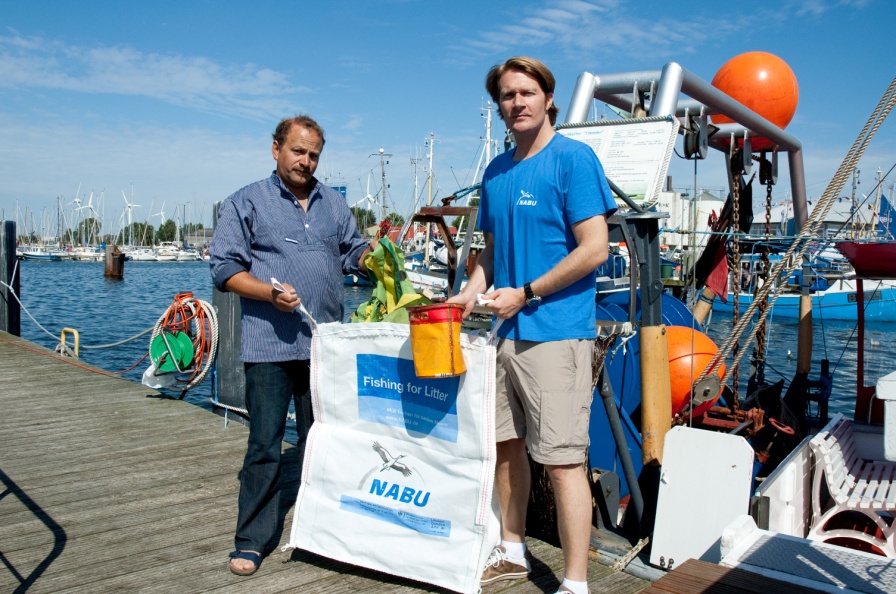Fishing for Litter in Germany
Fishing for Litteris an initiative based on cooperation with fisheries associations, in which fishermen bring ashore, voluntarily, the litter that is collected in the nets during the normal fishing operations. Fishermen are not financially compensated for their engagement, just the disposal logistics are for free. In 2011 NABU adopted the KIMO approach developed in year 2000 by launching first 2 harbours in Schleswig-Holstein Germany and therefore in the entire Baltic region. Today 6 harbours and about 60 fishermen have joined the scheme.
Fishermen are given special big bags to store the litter collected at sea and containers for waste disposal in selected harbours for free. So far all litter collected is analyzed in cooperation with project partners from waste industries and authorities in order to investigate waste composition, amount and potential recyclability of waste fractions such as metals or plastics.
All types of marine litter are targeted depending on the gear type used. Most amounts are from sea-floor litter collected with bottom-contacting gear.
The fishing for litter scheme is embedded in the wider NABU project “Plastic free Oceans” launched in 2010 and supports an intense public awareness campaign to address the issue of marine littering.
Facts
| Place / Location | Germany (pilot study in the German Baltic) |
|---|---|
| Commencement Date | May 2011 |
| Duration | Ongoing |
| Theme | Mitigation, Awareness (Cross-cutting) |
| Type of Initiative | Practice/ Activity/ Action |
| Initiated by |
NABU Nature and Biodiversity Conservation Union Germany |
|
Involved Stakeholders |
Fishermen & their associations, port authorities, regional waste industries, federal environmental authorities, waste recovery industries |
| Funding/Financial Support |
Initial funding in 2010/11 by Environmental Ministry BMU Germany and Federal Environment Agency (UBA). Since 2013 funding by Environmental Ministry Lower Saxony for 2 years to extend the project with regional authorities on the North Sea coast. Support by DSD – Der Grüne Punkt Deutschland - by covering the waste analysis. |
|
Success Rate |
Very Successful in public awareness raising and data gathering. Until end 2012 about 2 tonnes of litter has been collected. Since then the number of participating vessels has doubled. |
| Case Study prepared by |
Dr. Kim Cornelius Detloff Head of Marine Conservation NABU – Nature and Biodiversity Conservation Union Headquarters Berlin |
| Submitted by | Joana Mira Veiga, EUCC |
What is at Stake?
The fishing for litter scheme is embedded in the NABU project “Plastic-free Oceans” launched in 2010 and integrating also beach litter monitoring, beach cleanups, public awareness raising and education. More info: www.meere-ohne-plastik.de NABU adopted the voluntary KIMO approach running since year 2000. All litter types are targeted depending on the gear types used. Most amounts are from sea-floor litter collected with bottom-contacting gear. First results from a 2012 analysis indicate that most litter items originate from shipping, fisheries and other offshore activities.
Fishing for litter follows a three-channeled approach: Cleaning up marine litter, gathering valuable data and raising public awareness.
What is the Scale of the Problem?
Marine Litter constitutes a global concern and causes serious environmental and economic problems. We still have no reliable data on the total amount of marine litter in the seas. A study by the US Academy of Science estimated that even in 1997 up to 6.4 million tons of debris were entering our oceans each year. More than 20,000 tons of debris are dumped in the North each year. Approximately 75 percent of all debris is made up of plastics. UNEP (2006) estimates that up to 18.000 pieces of plastic are floating on every square kilometer of water surface. What we can see at the ocean’s surface is therefore just the very tip of the iceberg. According to figures from the North Sea, as well as from the waters around Australia, it has been estimated that up to 70 percent of the marine litter that enters the sea ends up on the seabed. The harmful effects of marine litter are as diverse as they are dramatic. Each year up to one million sea birds and 100,000 marine mammals die due to entanglement, ingestion, internal injury or poisoning.
Project/ Activity Results:
Most marine litter in the Baltic and North Sea region is concentrating at the sea-bottom. About 15% is washed ashore. Most litter collected is from the sea-floor.
Today, 6 harbours and about 60 fishermen have joined the project, more than 2 tons of litter has been collected and partly analyzed. 2 more North harbours are in preparation and will be launched this summer.
Since 2013 NABU agreed on a contract with the Federal State of Lower Saxony to extend the project in cooperation with federal authorities (National Park Authority, NLWKN, Fisheries Secretariat)
The project is of high media attraction, several tv-documentations have been produced.
Success and Fail factors and Lessons Learned:
The integration of regional stakeholders is of vital importance. We brought together fishermen and their associations, waste industries, harbor authorities and representatives from communities in order to jointly agree on logistics, communication, public relation, etc. We initiated a round table and started each harbour with a joint press conference. It is of additional valued to link the project with other marine litter related activities in the region and to ensure a constant communication and promotion of the regional projects, e.g. via info signs, info stands at local events, press releases, etc.
Additional Information on Finances:
Initial funding in 2010/11 from the Environmental Ministry BMU and the federal Environment Agency UBA.
Since 2013 funds from the Environmental Ministry Lower Saxony for 2 years (2013/14).
Logistical supports from regional waste industries.
Assessment of Project/ Activity Sustainability:
The voluntary scheme is a by-product of normal fishing operations. Accordingly there are not additional potential adverse impacts.
How Transferable is the Project/ Activity to other European Countries/Seas?
Highly transferable. Refer also to the KIMO approach in UK, NL, B, SWE and other comparable projects e.g. in Spain.
Available documentation and further information
http://www.nabu.de/themen/meere/plastik/fishingforlitter/
